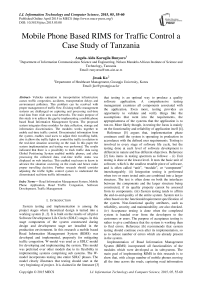Mobile Phone Based RIMS for Traffic Control a Case Study of Tanzania
Автор: Angela-Aida Karugila Runyoro, Jesuk Ko
Журнал: International Journal of Information Technology and Computer Science(IJITCS) @ijitcs
Статья в выпуске: 5 Vol. 7, 2015 года.
Бесплатный доступ
Vehicles saturation in transportation infrastructure causes traffic congestion, accidents, transportation delays and environment pollution. This problem can be resolved with proper management of traffic flow. Existing traffic management systems are challenged on capturing and processing real-time road data from wide area road networks. The main purpose of this study is to address the gap by implementing a mobile phone based Road Information Management System. The proposed system integrates three modules for data collection, storage and information dissemination. The modules works together to enable real-time traffic control. Disseminated information from the system, enables road users to adjust their travelling habit, also it allows the traffic lights to control the traffic in relation to the real-time situation occurring on the road. In this paper the system implementation and testing was performed. The results indicated that there is a possibility to track traffic data using Global Positioning System enabled mobile phones, and after processing the collected data, real-time traffic status was displayed on web interface. This enabled road users to know in advance the situation occurring on the roads and hence make proper travelling decision. Further research should consider adjusting the traffic lights control system to understand the disseminated real-time traffic information.
Road Information Management System, Mobile Phone Application, Road Traffic Congestion, Software Development, Traffic Management
Короткий адрес: https://sciup.org/15012285
IDR: 15012285
Текст научной статьи Mobile Phone Based RIMS for Traffic Control a Case Study of Tanzania
Published Online April 2015 in MECS
System testing and implementation is among the project stages where theoretical design is turned into a working system [1, 2] . It is built on the results of all prior Software Development Life Circle (SDLC) stages. In this stage components of the system constructed during design and development stage are installed in the production environment. In this research a mobile based Road Information Management System (RIMS) was developed and implemented, purposely for mitigating traffic congestion. W-model was used as a SDLC model for developing and implementing the system. This model was preferred over other models due to its flexibility in implementing systems comprising sub systems. The W-model incorporates testing into entire SDLC phases. The model clearly illustrates that testing should start at the very beginning of project. It is claimed in the literature [3]
that testing is an optimal way to produce a quality software application. A comprehensive testing management examines all components associated with the application. Even more, testing provides an opportunity to validate and verify things like the assumptions that went into the requirements, the appropriateness of the systems that the application is to run on. More likely though, in testing the focus is mainly on the functionality and reliability of application itself [4] .
Список литературы Mobile Phone Based RIMS for Traffic Control a Case Study of Tanzania
- Vaughan, P.J. System Implementation Success Factors; It’s Not Just the Technology. University of Colorado at Boulder. 2001; Available at the website: https:// net.educause.edu/ ir/library/pdf/CMR0122.pdf Accessed on 10th May 2014.
- Luo, L., Software Testing Techniques. Institute for software research international Carnegie mellon university Pittsburgh, PA, 2001. 15232(1-19): p. 19.
- Kosindrdecha, N. and J. Daengdej, A test case generation process and technique. J. Software Eng, 2010. 4: p. 265-287.
- Jenkins, N., A Software Testing Primer, in An Introduction to Software Testing. 2008, Creative Commons.
- Erdil, K., et al., Software Maintenance as Part of the Software Life Cycle. Comp180: Software Engineering Project, 2003.
- Jenkins, N., A Software Testing Primer. An Introduction to Software Testing, 2008.
- Runyoro, A.-A.K. and J. Ko, Real-Time Road Traffic Management Using Floating Car Data. International Journal of Fuzzy Logic and Intelligent Systems, 2013. 13(4): p. 269-276.
- Duncombe, R., Researching Impact of Mobile Phones for Development: Concepts, Methods and Lessons for Practice. Information Technology for Development, 2011. 17(4): p. 268-288.
- Duncombe, R. Understanding Mobile Phone Impact on Livelihoods in Developing Countries: A new Research Framework. Manchester Centre for Development Informatics, Working Paper 48, 2012; Available at the website: http:// www.sed.manchester.ac.uk/idpm/research/publications/wp/di/di_wp48.htm Accessed on 15th August 2014.
- Figueiredo, L., J.T. Machado, and J.R. Ferreira, Dynamical Analysis of Freeway Traffic. IEEE Transactions on Intelligent Transportation Systems, 2004. 5(4): p. 259-266.
- Ayala, D., et al. Communication Reduction for Floating Car Data-Based Traffic Information Systems. In Proceedings of IEEE Second International Conference on Advanced Geographic Information Systems, Applications, and Services (GEOPROCESSING), 2010.
- Anam, R., C.K. Ho, and T.Y. Lim, Tree Adapt: Web Content Adaptation for Mobile Devices. International Journal of Information Technology and Computer Science (IJITCS), 2014. 6(9): p. 1-13.
- Zheng, J., et al., On the Value of Static Analysis for Fault Detection in Software. Software Engineering, IEEE Transactions on, 2006. 32(4): p. 240-253.
- Rakitin, S.R., Software Verification and Validation for Practitioners and Managers. 2001: Artech House, Inc.
- Nidhra, S. and J. Dondeti, Black Box and White Box Testing Techniques – A Literature Review. International Journal of Embedded Systems and Applications (IJESA), 2012. 2(2): p. 29-50.
- Godwin-Jones, R., Emerging Technologies: Mobile Apps for Language Learning. Language Learning & Technology, 2011. 15(2): p. 2-11.


